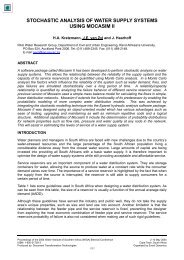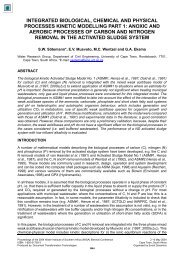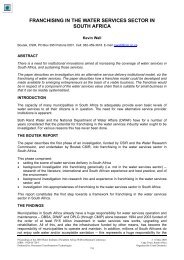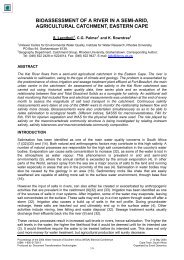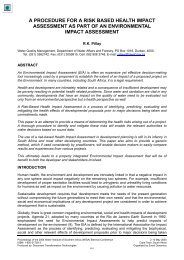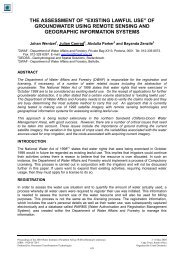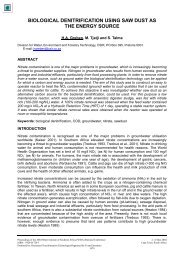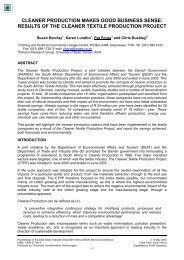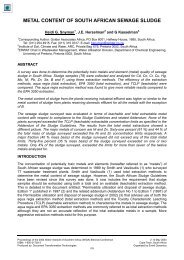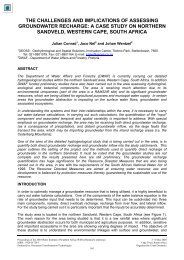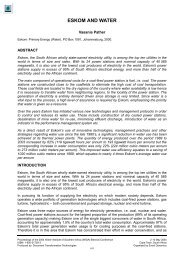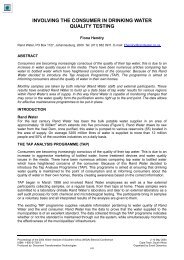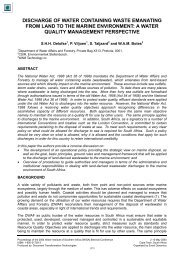Siobhan Jackson - eWISA
Siobhan Jackson - eWISA
Siobhan Jackson - eWISA
You also want an ePaper? Increase the reach of your titles
YUMPU automatically turns print PDFs into web optimized ePapers that Google loves.
INVESTIGATION OF SEEPAGE WATERS IN THE<br />
ETHEKWINI MUNICIPALITY<br />
<strong>Siobhan</strong> <strong>Jackson</strong><br />
Durban Metro Water Services, Wastewater Management Laboratory,<br />
PO Box 1038, Durban, 4000. Tel: (031) 302 4796. Fax: (031) 302 4747.<br />
E-mail: mailto:siobhanj@dmws.durban.gov.za<br />
ABSTRACT<br />
South Africa is acknowledged as a water scarce country and as such has to ensure that its water<br />
assets are utilised effectively to ensure sustainability. Although the eThekwini Municipality lies in<br />
the supposedly water rich province of KwaZulu-Natal, water stewardship is viewed with as much<br />
concern here as it is in other more arid provinces of the country. Treated water travels through<br />
approximately 12 000 km of mains distribution pipeline and sewage through more than 7 000 km of<br />
major sewerage pipes in the municipality. Water could be lost from either network and a system<br />
has therefore been put in place to try to establish the source of a seepage water before action is<br />
taken.<br />
Once a complaint of seepage has been received in the Call Centre, a plumbing team is sent out to<br />
investigate and, if the cause of the problem is not immediately obvious, a chemical sample is taken<br />
and brought back to the central laboratory for analysis. The presence of the major trihalomethanes<br />
(THMs) is used as a primary indicator of potable water. These compounds may however, also be<br />
found in sullage or grey water or in leaks from swimming pools. When there is doubt as to the<br />
identification of the water source, a second team of samplers from the laboratory is sent on site to<br />
take both chemical and bacteriological samples. In this way, costs to Water Operations are<br />
reduced, as effort is not put into tracing and digging seepages which turn out to be normal ground<br />
water. In addition, leaks of potable water traveling over some distance, which might otherwise have<br />
been considered as ground water, can be identified.<br />
INTRODUCTION<br />
During the 1980s the then Durban Water Services started trying to identify the source of seepage<br />
waters in order to optimise the use of digging and plumbing teams and reduce the amount of water<br />
lost in the system. At the start, a range of chemical and bacteriological tests was used and several<br />
days were necessary to complete the analyses and produce a result. Over the years, the testing<br />
has been refined and reduced to the present system where results are often available within hours<br />
of the sample having been taken.<br />
When a complaint of a seepage water is received in the Call Centre, the job is given a number and<br />
a plumbing team is sent to perform the initial investigation. If the cause is readily detected, such as<br />
an obvious rupture in a pipeline, the team takes action immediately. If the cause is not obvious, the<br />
team takes a chemical sample which is returned to the central laboratory for analysis. The basic<br />
analyses of pH and conductivity are performed as well as a gas chromatography (GC) analysis for<br />
the trihalomethanes (THMs) chloroform (CHCl3), dichlorobromomethane (CHCl2Br),<br />
dibromochloromethane (CHClBr2) and bromoform (CHBr3). In general, a potable water source<br />
provides strong trihalomethane peaks as shown in Figure 1, with very little background noise. In<br />
addition, if the source of the leak is relatively close to where the sample was taken, the conductivity<br />
of the sample should be close to that of the water supplied to the area.<br />
Proceedings of the 2004 Water Institute of Southern Africa (WISA) Biennial Conference 2 –6 May 2004<br />
ISBN: 1-920-01728-3 Cape Town, South Africa<br />
Produced by: Document Transformation Technologies Organised by Event Dynamics
Figure 1. GC profile of a potable water leak.<br />
Grey water or sullage also contains THMs but generally at a much reduced level owing to<br />
combination and reaction with the organic matter in the water. There is also a general increase in<br />
background noise. In addition, the conductivity of the water rises as a result of dissolved salts. An<br />
example of a sullage water profile is presented in Figure 2.<br />
Figure 2. GC profile of a sullage water leak.<br />
Sewage waters, Figure 3, generally have very low or no THMs present but can usually be identified<br />
by both their colour and odour. Ground waters, Figure 4, have no THMs, a variable pH and<br />
generally only a slight odour. As can be seen from figures 3 and 4, it is often difficult to discriminate<br />
between samples of sewage and ground waters purely on a GC spectrum. As a safeguard, all<br />
samples which do not produce clear THM peaks are resampled. A sampling team from the<br />
laboratory is sent to the site and takes bacteriological and chemical samples. As this sample is<br />
only taken at least two days after the first sample, if the seepage is from a potable leak the flow will<br />
generally have increased slightly. THMs should then be detectable as the surrounding organic<br />
matter will have become saturated and no longer absorb the compounds being used for analysis.
METHOD<br />
Figure 3. GC profile of a sewage water leak.<br />
Figure 4. GC profile of a ground water leak.<br />
The THMs are extracted from 50 mL of the seepage sample into 1 mL of pentane. The sample is<br />
allowed to settle and 1 µL of the separated pentane is injected into the GC, a Varian 3600. The GC<br />
is run using the electron capture detector (ECD).<br />
The parameters for the run are as follows:-<br />
Injection Volume: 1,0 µl Nitrogen gas is used<br />
Injection Port A: 200 0 C Split ratio: 11<br />
Detector B: 320 0 C Pressure: 8,0 psig<br />
Column B flow rate: 1,6 mL / min Column: SPB-1 (30m x 0,25 µm)<br />
Velocity: 28,8 cm / sec<br />
Oven Program<br />
70 0 C Isothermal for 5 minutes
Table 1. Ideal retention times for the various THMs under the above conditions.<br />
Group ID Retention Time (min)<br />
Pentane 1,88<br />
CHCl3<br />
CHBrCl2<br />
2,02<br />
2,34<br />
CHBr2Cl 2,91<br />
CHBr3<br />
Data Retrieval and Analysis<br />
A chromatogram is printed automatically after a run.<br />
3,88<br />
Sensitivity in µg / L with minimum detection limits in the order of 10 -1µ g / L.<br />
DISCUSSION<br />
As can be seen from the figures above, it is often difficult to distinguish the origin of seepage water<br />
based solely on the THM profile. Figures 1 and 2 both had strong THM peaks, but when the<br />
conductivity was examined it was seen that the sample for the potable leak was 27.8 mS/m, very<br />
close to that of the mains supply while that of the sullage sample was 68.1 mS/m. In addition,<br />
shaking the sample produced a light foam in the sullage sample and had no effect on the potable<br />
sample. Increases in conductivity have however been noted in potable water samples where the<br />
water has seeped through concrete or soil that has been treated with lime. Figures 3 and 4<br />
represent the sewage and ground water samples. Here, the profiles are very similar. The<br />
conductivities were 17.6 mS/m and 33.9 ms/m respectively, which would also not have been<br />
sufficient evidence to make a decision as to source. When the E. coli results were examined, they<br />
were >400 000 cfu/100mL and
taken to complete analyses and the additional costs involved have been found to outweigh the<br />
benefits obtained when all samples are subjected to the full battery.<br />
ACKNOWLEDGMENTS<br />
I would like to acknowledge the plumbing and sampling teams who diligently take samples, often<br />
under trying circumstances and the staff at the laboratory who analyse them with such skill.<br />
Without these people Durban would literally be pouring money down the drain.



